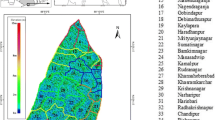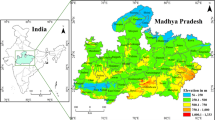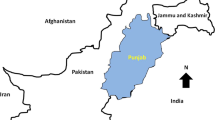Abstract
India being a developing economy dependent on climate-sensitive sector like agriculture is highly vulnerable to impacts of global climate change. Vulnerability to climate change, however, differs spatially within the country owing to regional differences in exposure, sensitivity, and adaptive capacity. The study uses the Hadley Centre Global Environment Model version 2-Earth System (HadGEM-ES) climate projections to assess the dynamics in vulnerability across four climate change exposure scenarios developed using Representative Concentration Pathways (RCPs). The analysis was carried out at subnational (district) level; the results were interpreted and reported for their corresponding agro-ecological zones. Vulnerability of each district was quantified using indicators capturing climatic variability, ecological and demographic sensitivity, and socio-economic capacity. Our analysis further assigns probabilities to vulnerability classes of all the 579 districts falling under different agro-ecological zones. The results of the vulnerability profile show that Western plains, Northern plains, and central highlands of the arid and semi-arid agro-ecological zones are the most vulnerable regions in the current scenario (1950–2000). In the future scenario (2050), it extends along districts falling within Deccan plateau and Central (Malwa) highlands, lying in the arid and semi-arid zones, along with regions vulnerable in the current scenario, recording the highest vulnerability score across all exposure scenarios. These regions exhibit highest degree of variation in climatic parameters, ecological fragility, socio-economic marginality, and limited accessibility to resources, generating conditions of high vulnerability. The study emphasizes on the priority to take up adaptive management actions in the identified vulnerable districts to not only reduce risks of climate change, but also enhance their inherent capacity to withstand any future changes in climate. It provides a systematic approach to explicitly identify vulnerable regions, where regional planners and policy makers can build on existing adaptation decision-making by utilizing an interdisciplinary approach in the context of global change scenario.











Similar content being viewed by others
References
Abdul Haris AV, Biswas S, Chhabra V (2013) Impact of climate change on wheat and winter maize over a sub-humid climatic environment. Curr Sci 104:206–214
Adger WN (2006) Vulnerability. Glob Environ Chang 16:268–281. doi:10.1016/j.gloenvcha.2006.02.006
Aggarwal PK (2003) Impact of climate change on Indian agriculture. J Plant Biol 30(2):189–198
Ahmad QK, Warrick RA, Downing TE et al (2001) Methods and tools. Climate change 2001: impacts, adaptation, and vulnerability. Contribution of II to the Third Assessment Report of the Intergovernmental Panel on Climate Change. Cambridge University Press, Cambridge, pp 105–143
Aryal S, Cockfield G, Maraseni TN (2014) Vulnerability of Himalayan transhumant communities to climate change. Clim Chang. doi:10.1007/s10584-014-1157-5
Berkhout F, van den Hurk B, Bessembinder J et al (2013) Framing climate uncertainty: socio-economic and climate scenarios in vulnerability and adaptation assessments. Reg Environ Chang 14:879–893. doi:10.1007/s10113-013-0519-2
Betts RA, Golding N, Gonzalez P, et al (2015) Climate and land use change impacts on global terrestrial ecosystems and river flows in the HadGEM2-ES Earth system model using the representative concentration pathways. 2000:1317–1338. doi: 10.5194/bg-12-1317-2015
Brenkert AL, Malone EL (2005) Modeling vulnerability and resilience to climate change: a case study of India and Indian states. Clim Chang 72:57–102. doi:10.1007/s10584-005-5930-3
Brooks N, Neil Adger W, Mick Kelly P (2005) The determinants of vulnerability and adaptive capacity at the national level and the implications for adaptation. Glob Environ Chang 15:151–163. doi:10.1016/j.gloenvcha.2004.12.006
Byjesh K, Kumar SN, Aggarwal PK (2010) Simulating impacts, potential adaptation and vulnerability of maize to climate change in India. Mitig Adapt Strateg Glob Chang 15:413–431. doi:10.1007/s11027-010-9224-3
Carter TR, Parry ML, Nishioka S, et al. (1996) Technical guidelines for assessing climate change impacts and adaptations. Climate change 1995: impacts, adaptations and mitigation of climate change: scientific-technical analyses. Contribution of Working Group II to the Second Assessment Report of the Intergovernmental Panel on Climate Change. Cambridge University Press, Cambridge
Carter TR, LaRovere EL, Jones RN et al (2001) Developing and applying scenarios. Climate change 2001: impacts, adaptation, and vulnerability. Contribution of Working Group II to the Third Assessment Report of the Intergovernmental Panel on Climate Change. Cambridge University Press, Cambridge
Chakraborty A, Joshi PK (2014) Mapping disaster vulnerability in India using analytical hierarchy process. Geomat Nat Hazards Risk 0:1–19. doi: 10.1080/19475705.2014.897656
Chaturvedi R, Joshi J, Jayaraman M (2012) Multi-model climate change projections for India under representative concentration pathways. Curr … 103:1–12
Ciurean RL, Schröter D (2013) Conceptual frameworks of vulnerability assessments for natural disasters reduction. 3–32.
Dai A (2013) Increasing drought under global warming in observations and models. Nat Clim Chang 3:52–58
Dash SK, Jenamani RK, Kalsi SR, Panda SK (2007) Some evidence of climate change in twentieth-century India. Clim Chang 85:299–321. doi:10.1007/s10584-007-9305-9
Dessai S, Lu X, Risbey JS (2005) On the role of climate scenarios for adaptation planning. Glob Environ Chang 15:87–97
Downing TE, Patwardhan A (2004) Assessing vulnerability for climate adaptation. In: Lim B, Spanger-Siegfried E (eds) Adaptation policy frameworks for climate change: developing strategies, policies, and measures, chapter 3. Cambridge University Press, Cambridge
Downing TE, Butterfield R, Cohen S, et al (2001) Climate change vulnerability: linking impacts and adaptation. Report to the Governing Council of the United Nations Programme
Emanuel K (2005) Increasing destructiveness of tropical cyclones over the past 30 years. Nature 436:686–688
FAO (1996) Guidelines: agro-ecological zoning. Food and Agricultural Organisation Soils Bulletin, Rome
Feng S, Fu Q (2013) Expansion of global drylands under a warming climate. Atmos Chem Phys 13:10081–10094. doi:10.5194/acp-13-10081-2013
Feng S, Hu Q, Huang W et al (2014) Projected climate regime shift under future global warming from multi-model, multi-scenario CMIP5 simulations. Glob Planet Chang 112:41–52. doi:10.1016/j.gloplacha.2013.11.002
Fischer G, Shah M, Velthuizen HV (2002) Climate change and agricultural vulnerability. International Institute for Applied Systems Analysis, Vienna
Fischer G, Shah M, Tubiello FN, van Velhuizen H (2005) Socio-economic and climate change impacts on agriculture: an integrated assessment, 1990–2080. Philos Trans R Soc Lond B Biol Sci 360:2067–2083. doi:10.1098/rstb.2005.1744
Füssel H-M (2007) Vulnerability: a generally applicable conceptual framework for climate change research. Glob Environ Chang 17:155–167. doi:10.1016/j.gloenvcha.2006.05.002
Gallopin GC (1997) Indicators and their use: information for decision-making. SCOPE—Scientific Committee on Problems of the Environment International Council of Scientific Unions 58, 13–27
Gbetibouo GA, Hassan RM (2005) Measuring the economic impact of climate change on major South African field crops: a Ricardian approach. Glob Planet Chang 47:143–152. doi:10.1016/j.gloplacha.2004.10.009
Hahn MB, Riederer AM, Foster SO (2009) The Livelihood Vulnerability Index: a pragmatic approach to assessing risks from climate variability and change—a case study in Mozambique. Glob Environ Chang 19:74–88. doi:10.1016/j.gloenvcha.2008.11.002
Hijmans RJ, Cameron SE, Parra JL et al (2005) Very high resolution interpolated climate surfaces for global land areas. Int J Climatol 25:1965–1978. doi:10.1002/joc.1276
Hinkel J (2011) “Indicators of vulnerability and adaptive capacity”: towards a clarification of the science–policy interface. Glob Environ Chang 21:198–208. doi:10.1016/j.gloenvcha.2010.08.002
Hirabayashi Y, Mahendran R, Koirala S et al (2013) Global flood risk under climate change. Nat Clim Chang 3:816–821
Hiremath DB, Shiyani RL (2013) Analysis of vulnerability indices in various agro-climatic zones of Gujarat. Indian J Agric Econ 68:122–137
Holmgren M, Stapp P, Dickman CR et al. (2005) Extreme climatic events shape arid and semiarid ecosystems, 94
Howden SM, Soussana J-F, Tubiello FN et al (2007) Adapting agriculture to climate change. Proc Natl Acad Sci U S A 104:19691–19696. doi:10.1073/pnas.0701890104
ICIMOD (2014) Hindu kush Himalaya Region, Regional Information. (http://www.icimzod.org/?q=1137).
INCCA (2010) Climate change and India: a 4X4 assessment—a sectorial and regional analysis for 2030s. Ministry of Environment and Forest, Government of India
Ionescu C, Klein RT, Hinkel J et al (2009) Towards a formal framework of vulnerability to climate change. Environ Model Assess 14:1–16. doi:10.1007/s10666-008-9179-x
IPCC (2007) Climate change 2007: the physical science basis. Contribution of Working Group I to the Fourth Assessment Report of the Intergovernmental Panel on Climate Change
IPCC (2014) Climate change 2014: impacts, adaptation and vulnerability—summary for policy makers, Contribution of Working Group II to the Fifth Assessment Report of the Intergovernmental panel on Climate Change. World Meterological Organization, Geneva
Iyengar SS, Sudarshan P (1982) A method of classifying regions from multivariate data. Economic and Political Weekly, Special Article, 2043–2052
Jamir C, Sharma N, Sengupta A, Ravindranath NH (2012) Farmers’ vulnerability to climate variability in Dimapur district of Nagaland, India. Reg Environ Chang 13:153–164. doi:10.1007/s10113-012-0324-3
Jodha NS, Singh NP, Bantilan MCS (2012) Enhancing farmers’ adaptation to climate change in arid and semi-arid agriculture of India: evidences from indigenous practices: developing international public goods from development oriented projects. Working Paper Series No. 32. International Crops Research Institute for the Semi-Arid Tropics, India.
Kates RW, Wilbanks TJ (2003) Making the global local: responding to climate change concerns from the ground. Environment 45:12–23
Khan SA, Kumar S, Hussain MZ, Kalra N (2009) Climate change, climate variability and Indian agriculture: impacts vulnerability and adaptation strategies. In: Singh SN (ed) Climate change and crops. Springer, Berlin, Heidelberg, pp 19–38
Kumar K (2007) Climate change studies in Indian agriculture. Econ Polit Wkly 42:15–18
Kumar KSK, Parikh J (2001) Indian agriculture and climate sensitivity. Glob Environ Chang 11:147–154. doi:10.1016/S0959-3780(01)00004-8
Kumar P, Wiltshire A, Mathison C, et al (2013) Downscaled climate change projections with uncertainty assessment over India using a high resolution multi-model approach. Sci Total Environ 468-469 Su: S18–30. doi: 10.1016/j.scitotenv.2013.01.051
Kumar SN, Aggarwal PK, Rani DNS et al (2014) Vulnerability of wheat production to climate change in India. Clim Res 59:173–187. doi:10.3354/cr01212
Luers AL, Lobell DB, Sklar LS, et al (2003) A method for quantifying vulnerability, applied to the agricultural system of the Yaqui Valley, Mexico. 13:255–267. doi: 10.1016/S0959-3780(03)00054-2
Mall RK, Singh R, Gupta A, et al (2006) Impact of climate change on Indian agriculture: a review. Clim Change 78:445–478. doi:10.1007/s10584-005-9042-x
McCarthy JJ, Canziani OF, Leary NA et al (2001) Climate change 2001: impacts, adaptation and vulnerability. Cambridge University Press, Cambridge
McKenzie Hedger M, Connell R, Bramwell P (2006) Bridging the gap: empowering adaptation decision-making through the UK Climate Impacts Programme. Clim Policy 6:201–215
Mearns LO, Hulme M, Carter TR (2001) Climate scenario development. Climate change 2001: the scientific basis. Contribution of Working Group I to the Third Assessment Report of the Intergovernmental Panel on Climate Change. Cambridge University Press, Cambridge, pp 739–768
Meehl GA, Tebaldi C (2004) More intense, more frequent, and longer lasting heat waves in the 21st century. Science 305:994–997. doi:10.1126/science.1098704
Mishra D, Sahu NC, Sahoo D (2015) Impact of climate change on agricultural production of Odisha (India): a Ricardian analysis. Reg Environ Chang. doi:10.1007/s10113-015-0774-5
MoA (2013) State of Indian Agriculture 2012-2013. Government of India, New Delhi
Moss RH, Edmonds JA, Hibbard KA (2010) The next generation of scenarios for climate change research and assessment. Nature 463:747–56. doi:10.1038/nature08823
Murthy CS, Laxman B, Sesha Sai MVR (2015) Geospatial analysis of agricultural drought vulnerability using a composite index based on exposure, sensitivity and adaptive capacity. Int J Disaster Risk Reduct 12:163–171. doi:10.1016/j.ijdrr.2015.01.004
NATCOM (2004) India first National Communication to UNFCCC. Ministry of Environment and Forest, Government of India
Nelson GC, Rosegrant MW, Koo J, et al (2009) Climate change impacts on agriculture and costs of adaptation. 1–19. doi: 10.2499/0896295354
O’Brien K, Leichenko R, Kelkar U et al (2004) Mapping vulnerability to multiple stressors: climate change and globalization in India. Glob Environ Chang 14:303–313. doi:10.1016/j.gloenvcha.2004.01.001
Pamungkas A, Bekessy SA, Lane R (2014) Vulnerability modelling to improve assessment process on community vulnerability. Procedia - Soc Behav Sci 135:159–166. doi:10.1016/j.sbspro.2014.07.341
Pandey R, Jha S (2012) Climate vulnerability index—measure of climate change vulnerability to communities: a case of rural Lower Himalaya, India. Mitig Adapt Strateg Glob Chang 17:487–506. doi:10.1007/s11027-011-9338-2
Parry ML, Rosenzweig C, Iglesias A et al (2004) Effects of climate change on global food production under SRES emissions and socio-economic scenarios. Glob Environ Chang 14:53–67. doi:10.1016/j.gloenvcha.2003.10.008
Patel NR (2007) Remote sensing and GIS application in agro-ecological zoning. In: Sharma HS, Binda PR (eds) Modeling in resource management and environment through geomatics. Concept Publishing Company, New Delhi
Preston BL, Yuen EJ, Westaway RM (2011) Putting vulnerability to climate change on the map: a review of approaches, benefits, and risks. Sustain Sci 6:177–202. doi:10.1007/s11625-011-0129-1
Ramirez-Villegas J, Jarvis A, Läderach P (2013) Empirical approaches for assessing impacts of climate change on agriculture: the EcoCrop model and a case study with grain sorghum. Agric For Meteorol 170:67–78. doi:10.1016/j.agrformet.2011.09.005
Ravindranath NH, Rao S, Sharma N et al (2011) Climate change vulnerability profiles for North East India. Curr Sci 101:384–394
Rosenzweig C, Hillel D (1998) Climate change and the global harvest: potential impacts of the greenhouse effect on agriculture. Oxford University Press, Oxford
Schneider SH, Kuntz-Duriseti K (2002) Uncertainty and climate change policy. Climate change policy: a survey. Island Press, Washington, DC
Sehgal J, Mandal DK, Mandal C, Vadivelu S (1992) Agro-ecological zones of India. Second Edition. Nagpur, India. Technical Bulletin, No. 24. NBSS & LUP (ICAR). p. 130
Sehgal VK, Singh MR, Chaudhary A, et al (2013) Vulnerability of agriculture to climate change : district level assessment in the Indo-Gangetic Plains
Shinde S, Modak P (2013) Vulnerability of Indian agriculture to climate change. In: Climate vulnerability: understanding and addressing threats to essential resources. Elsevier Inc., pp 139–152
Sietz D, Lüdeke MKB, Walther C (2011) Categorisation of typical vulnerability patterns in global drylands. Glob Environ Chang 21:431–440. doi:10.1016/j.gloenvcha.2010.11.005
Singh NP, Bantilan C, Byjesh K (2014) Vulnerability and policy relevance to drought in the semi-arid tropics of Asia—a retrospective analysis. Weather Clim Extrem 3:54–61. doi:10.1016/j.wace.2014.02.002
Smit B, Pilifosova O (2003) From adaptation to adaptive capacity and vulnerability reduction. Climate change, adaptive capacity and development. Imperial College Press, London
Smith JB, Schellnhuber HJ, Qader Mirza M et al (2001) Vulnerability to climate change and reasons for concern: a synthesis, climate change 2001: impacts, adaptation, and vulnerability. Cambridge University Press, Cambridge, pp 913–967
Soares MA, Gagnon AS, Doherty RM (2012) Conceptual elements of climate change vulnerability assessments: a review. Int J Clim Chang Strateg Manag 4(1):6–35
Soora NK, Aggarwal PK, Saxena R et al (2013) An assessment of regional vulnerability of rice to climate change in India. Clim Chang 118:683–699. doi:10.1007/s10584-013-0698-3
Tambe S, Arrawatia ML, Bhutia NT, Swaroop B (2011) Rapid, cost-effective and high resolution assessment of climate-related vulnerability of rural communities of Sikkim Himalaya, India
Van Vuuren DP, Edmonds J, Kainuma M et al (2011) The representative concentration pathways: an overview. Clim Chang 109(1-2):5–31
Varadan RJ, Kumar P (2015) Mapping agricultural vulnerability of Tamil Nadu, India to climate change : a dynamic approach to take forward the vulnerability assessment methodology. Clim Chang 159–181. doi: 10.1007/s10584-015-1327-0
Vogel C, O’Brien K (2004) Vulnerability and global environmental change: rhetoric and reality. AVISO–Information Bulletin on Global Environmental Change and Human Security 13
Wayne GP (2013). The beginner’s guide to representative concentration pathways. Version 1.0. Skeptical Science. http://www.skepticalscience.com/rcp.php
Wilby R, McKenzie Hedger M, Parker C (2004) What we need to know and when: decision-makers’ perspectives on climate change science. Climate Change Unit Environment Agency, London, 41 pp
Wilk J, Hjerpe M, Jonsson AC, et al (2013) A guidebook for integrated assessment and management of vulnerability to climate change. CSPR report Nr 13:01 Centre for Climate Science and Policy Research, Norrköping, Sweden and NORD-STAR Working Paper Series 2013-02
Acknowledgments
RS and PKJ acknowledge the support of the Ministry of Environment & Forests (MoEF), Government of India (GoI) (Project Serial Number: R&D/NNRMS/2/2013-14). AC acknowledges HSBC Climate Scholarship of TERI University for funding her doctoral research. The authors are thankful to the four anonymous reviewers, advisor and the editor of the journal for providing constructive comments and recommendations on earlier versions of the manuscript. We also acknowledge Ms. Niharika Tyagi for proof-reading the manuscript.
Author information
Authors and Affiliations
Corresponding author
Rights and permissions
About this article
Cite this article
Shukla, R., Chakraborty, A. & Joshi, P.K. Vulnerability of agro-ecological zones in India under the earth system climate model scenarios. Mitig Adapt Strateg Glob Change 22, 399–425 (2017). https://doi.org/10.1007/s11027-015-9677-5
Received:
Accepted:
Published:
Issue Date:
DOI: https://doi.org/10.1007/s11027-015-9677-5




